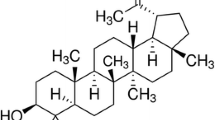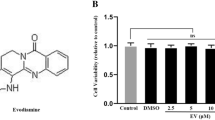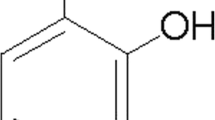Abstract
Over-activated microglial cells are known to be implicated in various neurological diseases, such as Alzheimer’s disease (AD), Parkinson’s disease (PD), and multiple sclerosis. Our previous reports have shown that ZL006, a compound with a hydrophobic ring A and a hydrophilic ring B with a carboxyl group, exhibited stronger neuroprotective activity in vitro and in vivo. However, the directly anti-inflammatory effects of these compounds in the central nervous system (CNS) have not been elucidated. In the present study, as a part of our ongoing screening experiment to evaluate the anti-inflammatory effects of new compounds, a newly synthesized 4-((5-bromo-3-chloro-2-hydroxybenzyl) amino)-2-hydroxybenzoic acid (LX007) was used to examine whether it could reduce the inflammatory responses of activated microglia. Our results indicated that LX007 inhibited lipopolysaccharide (LPS)-stimulated nitric oxide (NO) and prostaglandin E2 (PGE2) expression, as well as their regulatory gene-inducible NO syntheses (iNOS) and cyclooxygenase-2 (COX-2) in LPS-treated primary microglia. LPS-induced production from microglia of interleukin (IL)-1β, IL-6, and tumor necrosis factor (TNF-α) was also significantly attenuated by LX007. Mechanistically, LX007 potently suppressed phosphorylation of mitogen-activated protein kinases (MAPKs) and nuclear factor-kappa B (NF-κB) p65 nuclear translocation in LPS-induced microglia. We therefore conclude that LX007 exhibits anti-inflammatory effects in LPS-stimulated microglial cells by inhibiting pro-inflammatory mediators corresponding to the downregulating of MAPKs and NF-κB activation. Taken together, the present study indicated that LX007 may have potential to be developed into an anti-inflammatory agent in the future.







Similar content being viewed by others
References
Glass, C.K., K. Saijo, B. Winner, M.C. Marchetto, and F.H. Gage. 2010. Mechanisms underlying inflammation in neurodegeneration. Cell 140: 918–934.
Lucchinetti, C.F., B.F. Popescu, R.F. Bunyan, N.M. Moll, S.F. Roemer, H. Lassmann, W. Bruck, J.E. Parisi, B.W. Scheithauer, C. Giannini, S.D. Weigand, J. Mandrekar, and R.M. Ransohoff. 2011. Inflammatory cortical demyelination in early multiple sclerosis. The New England Journal of Medicine 365: 2188–2197.
Sarlus, H., and M.T. Heneka. 2017. Microglia in Alzheimer’s disease. The Journal of Clinical Investigation 127: 3240–3249.
Hanisch, U.K., and H. Kettenmann. 2007. Microglia: active sensor and versatile effector cells in the normal and pathologic brain. Nature Neuroscience 10: 1387–1394.
Liu, B., and J.S. Hong. 2003. Role of microglia in inflammation-mediated neurodegenerative diseases: mechanisms and strategies for therapeutic intervention. The Journal of Pharmacology and Experimental Therapeutics 304: 1–7.
He, L.X., X. Tong, J. Zeng, Y. Tu, S. Wu, M. Li, H. Deng, M. Zhu, X. Li, H. Nie, L. Yang, and F. Huang. 2016. Paeonol suppresses neuroinflammatory responses in LPS-activated microglia cells. Inflammation 39: 1904–1917.
Kaminska, B. 2005. MAPK signalling pathways as molecular targets for anti-inflammatory therapy—from molecular mechanisms to therapeutic benefits. Biochimica et Biophysica Acta 1754: 253–262.
Xu, X., P. Yin, C. Wan, X. Chong, M. Liu, P. Cheng, J. Chen, F. Liu, and J. Xu. 2014. Punicalagin inhibits inflammation in LPS-induced RAW264.7 macrophages via the suppression of TLR4-mediated MAPKs and NF-kappaB activation. Inflammation 37: 956–965.
Chao, C.C., S. Hu, T.W. Molitor, E.G. Shaskan, and P.K. Peterson. 1992. Activated microglia mediate neuronal cell injury via a nitric oxide mechanism. Journal of Immunology 149: 2736–2741.
Han, L., K. Yin, S. Zhang, Z. Wu, C. Wang, Q. Zhang, J. Pan, B. Chen, J. Li, R. Tan, and Y. Xu. 2013. Dalesconols B inhibits lipopolysaccharide induced inflammation and suppresses NF-kappaB and p38/JNK activation in microglial cells. Neurochemistry International 62: 913–921.
Xing, B., A.D. Bachstetter, and L.J. Van Eldik. 2011. Microglial p38alpha MAPK is critical for LPS-induced neuron degeneration, through a mechanism involving TNFalpha. Molecular Neurodegeneration 6: 84.
Zhou, L., F. Li, H.B. Xu, C.X. Luo, H.Y. Wu, M.M. Zhu, W. Lu, X. Ji, Q.G. Zhou, and D.Y. Zhu. 2010. Treatment of cerebral ischemia by disrupting ischemia-induced interaction of nNOS with PSD-95. Nature Medicine 16: 1439–1443.
Weng, L., H. Zhang, X. Li, H. Zhan, F. Chen, L. Han, Y. Xu, and X. Cao. 2017. Ampelopsin attenuates lipopolysaccharide-induced inflammatory response through the inhibition of the NF-kappaB and JAK2/STAT3 signaling pathways in microglia. International Immunopharmacology 44: 1–8.
Kyriakis, J.M., and J. Avruch. 2012. Mammalian MAPK signal transduction pathways activated by stress and inflammation: a 10-year update. Physiological Reviews 92: 689–737.
Ridder, D.A., and M. Schwaninger. 2009. NF-kappaB signaling in cerebral ischemia. Neuroscience 158: 995–1006.
Bronzuoli, M.R., A. Iacomino, L. Steardo, and C. Scuderi. 2016. Targeting neuroinflammation in Alzheimer’s disease. Journal of Inflammation Research 9: 199–208.
Shadfar, S., C.J. Hwang, M.S. Lim, D.Y. Choi, and J.T. Hong. 2015. Involvement of inflammation in Alzheimer’s disease pathogenesis and therapeutic potential of anti-inflammatory agents. Archives of Pharmacal Research 38: 2106–2119.
Banati, R.B., S.E. Daniel, and S.B. Blunt. 1998. Glial pathology but absence of apoptotic nigral neurons in long-standing Parkinson’s disease. Movement disorders : official journal of the Movement Disorder Society 13: 221–227.
Knott, C., G. Stern, and G.P. Wilkin. 2000. Inflammatory regulators in Parkinson’s disease: iNOS, lipocortin-1, and cyclooxygenases-1 and -2. Molecular and Cellular Neurosciences 16: 724–739.
Imamura, K., N. Hishikawa, M. Sawada, T. Nagatsu, M. Yoshida, and Y. Hashizume. 2003. Distribution of major histocompatibility complex class II-positive microglia and cytokine profile of Parkinson’s disease brains. Acta Neuropathologica 106: 518–526.
Luth, H.J., M. Holzer, U. Gartner, M. Staufenbiel, and T. Arendt. 2001. Expression of endothelial and inducible NOS-isoforms is increased in Alzheimer’s disease, in APP23 transgenic mice and after experimental brain lesion in rat: evidence for an induction by amyloid pathology. Brain Research 913: 57–67.
Lai, K.S.P., C.S. Liu, A. Rau, K.L. Lanctot, C.A. Kohler, M. Pakosh, A.F. Carvalho, and N. Herrmann. 2017. Peripheral inflammatory markers in Alzheimer’s disease: a systematic review and meta-analysis of 175 studies. Journal of neurology, neurosurgery, and psychiatry.
Stypula, G., J. Kunert-Radek, H. Stepien, K. Zylinska, and M. Pawlikowski. 1996. Evaluation of interleukins, ACTH, cortisol and prolactin concentrations in the blood of patients with Parkinson’s disease. Neuroimmunomodulation 3: 131–134.
Mrak, R.E., and W.S. Griffin. 2005. Glia and their cytokines in progression of neurodegeneration. Neurobiology of Aging 26: 349–354.
Simi, A., N. Tsakiri, P. Wang, and N.J. Rothwell. 2007. Interleukin-1 and inflammatory neurodegeneration. Biochemical Society Transactions 35: 1122–1126.
Zhang, Y.Y., Y.C. Fan, M. Wang, D. Wang, and X.H. Li. 2013. Atorvastatin attenuates the production of IL-1beta, IL-6, and TNF-alpha in the hippocampus of an amyloid beta1-42-induced rat model of Alzheimer’s disease. Clinical Interventions in Aging 8: 103–110.
Lim, G.P., T. Chu, F. Yang, W. Beech, S.A. Frautschy, and G.M. Cole. 2001. The curry spice curcumin reduces oxidative damage and amyloid pathology in an Alzheimer transgenic mouse. The Journal of neuroscience : the official journal of the Society for Neuroscience 21: 8370–8377.
Yang, F., G.P. Lim, A.N. Begum, O.J. Ubeda, M.R. Simmons, S.S. Ambegaokar, P.P. Chen, R. Kayed, C.G. Glabe, S.A. Frautschy, and G.M. Cole. 2005. Curcumin inhibits formation of amyloid beta oligomers and fibrils, binds plaques, and reduces amyloid in vivo. The Journal of Biological Chemistry 280: 5892–5901.
Koistinaho, M., M.I. Kettunen, G. Goldsteins, R. Keinanen, A. Salminen, M. Ort, J. Bures, D. Liu, R.A. Kauppinen, L.S. Higgins, and J. Koistinaho. 2002. Beta-amyloid precursor protein transgenic mice that harbor diffuse A beta deposits but do not form plaques show increased ischemic vulnerability: role of inflammation. Proceedings of the National Academy of Sciences of the United States of America 99: 1610–1615.
Saporito, M.S., E.M. Brown, M.S. Miller, and S. Carswell. 1999. CEP-1347/KT-7515, an inhibitor of c-jun N-terminal kinase activation, attenuates the 1-methyl-4-phenyl tetrahydropyridine-mediated loss of nigrostriatal dopaminergic neurons in vivo. The Journal of Pharmacology and Experimental Therapeutics 288: 421–427.
Lund, S., P. Porzgen, A.L. Mortensen, H. Hasseldam, D. Bozyczko-Coyne, S. Morath, T. Hartung, M. Bianchi, P. Ghezzi, M. Bsibsi, S. Dijkstra, and M. Leist. 2005. Inhibition of microglial inflammation by the MLK inhibitor CEP-1347. Journal of Neurochemistry 92: 1439–1451.
Yuan, L., S. Liu, X. Bai, Y. Gao, G. Liu, X. Wang, D. Liu, T. Li, A. Hao, and Z. Wang. 2016. Oxytocin inhibits lipopolysaccharide-induced inflammation in microglial cells and attenuates microglial activation in lipopolysaccharide-treated mice. Journal of Neuroinflammation 13: 77.
Ghosh, S., and M.S. Hayden. 2008. New regulators of NF-kappaB in inflammation. Nature Reviews. Immunology 8: 837–848.
Guo, R.B., G.F. Wang, A.P. Zhao, J. Gu, X.L. Sun, and G. Hu. 2012. Paeoniflorin protects against ischemia-induced brain damages in rats via inhibiting MAPKs/NF-kappaB-mediated inflammatory responses. PLoS One 7: e49701.
Bansal, K., A.Y. Sinha, D.S. Ghorpade, S.K. Togarsimalemath, S.A. Patil, S.V. Kaveri, K.N. Balaji, and J. Bayry. 2010. Src homology 3-interacting domain of Rv1917c of Mycobacterium tuberculosis induces selective maturation of human dendritic cells by regulating PI3K-MAPK-NF-kappaB signaling and drives Th2 immune responses. The Journal of Biological Chemistry 285: 36511–36522.
Funding
This study was supported by the National Natural Science Foundation of China (81701170, 81630028), the Natural Science Foundation of Jiangsu Province of China (BK20170122), the Science and Technology Department of Jiangsu Province (BE2016610), and Jiangsu Province Key Medical Discipline (ZDXKA2016020).
Author information
Authors and Affiliations
Corresponding author
Ethics declarations
Conflict of Interest
The authors declare that they have no conflicts of interest.
Rights and permissions
About this article
Cite this article
Cao, X., Jin, Y., Zhang, H. et al. The Anti-inflammatory Effects of 4-((5-Bromo-3-chloro-2-hydroxybenzyl) amino)-2-hydroxybenzoic Acid in Lipopolysaccharide-Activated Primary Microglial Cells. Inflammation 41, 530–540 (2018). https://doi.org/10.1007/s10753-017-0709-z
Published:
Issue Date:
DOI: https://doi.org/10.1007/s10753-017-0709-z




